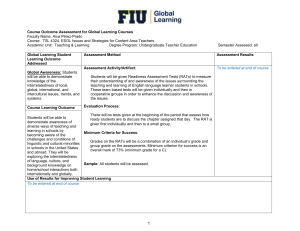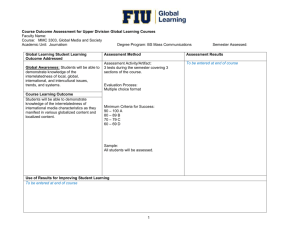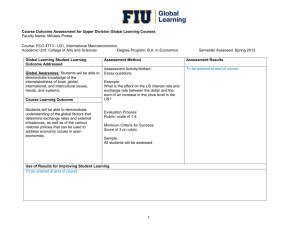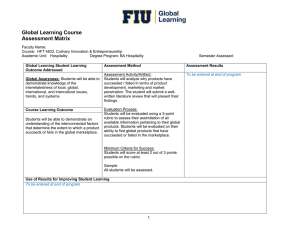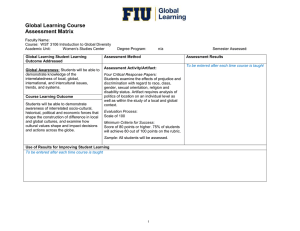Assessment Results - FIU Global Learning
advertisement
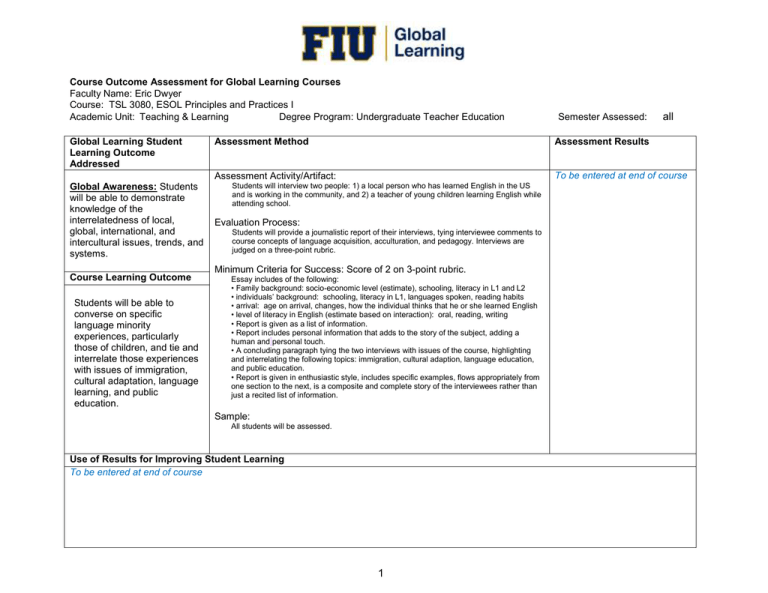
Course Outcome Assessment for Global Learning Courses Faculty Name: Eric Dwyer Course: TSL 3080, ESOL Principles and Practices I Academic Unit: Teaching & Learning Degree Program: Undergraduate Teacher Education Global Learning Student Learning Outcome Addressed Global Awareness: Students will be able to demonstrate knowledge of the interrelatedness of local, global, international, and intercultural issues, trends, and systems. Course Learning Outcome Students will be able to converse on specific language minority experiences, particularly those of children, and tie and interrelate those experiences with issues of immigration, cultural adaptation, language learning, and public education. Semester Assessed: all Assessment Method Assessment Results Assessment Activity/Artifact: To be entered at end of course Students will interview two people: 1) a local person who has learned English in the US and is working in the community, and 2) a teacher of young children learning English while attending school. Evaluation Process: Students will provide a journalistic report of their interviews, tying interviewee comments to course concepts of language acquisition, acculturation, and pedagogy. Interviews are judged on a three-point rubric. Minimum Criteria for Success: Score of 2 on 3-point rubric. Essay includes of the following: • Family background: socio-economic level (estimate), schooling, literacy in L1 and L2 • individuals’ background: schooling, literacy in L1, languages spoken, reading habits • arrival: age on arrival, changes, how the individual thinks that he or she learned English • level of literacy in English (estimate based on interaction): oral, reading, writing • Report is given as a list of information. • Report includes personal information that adds to the story of the subject, adding a human and personal touch. • A concluding paragraph tying the two interviews with issues of the course, highlighting and interrelating the following topics: immigration, cultural adaption, language education, and public education. • Report is given in enthusiastic style, includes specific examples, flows appropriately from one section to the next, is a composite and complete story of the interviewees rather than just a recited list of information. Sample: All students will be assessed. Use of Results for Improving Student Learning To be entered at end of course 1 Course Outcome Assessment for Global Learning Courses Faculty Name: Eric Dwyer Course: TSL 3080, ESOL Principles and Practices I Academic Unit: Teaching & Learning Degree Program: Undergraduate Teacher Education Global Learning Student Learning Outcome Addressed Global Perspective: Students will be able to develop a multiperspective analysis of local, global, international, and intercultural problems. Semester Assessed: Assessment Method Assessment Results Assessment Activity/Artifact: To be entered at end of course Team activity: Students will research and present a WebQuest on displacement, taking into consideration issues of human rights, racism, or oppression of those displaced. Evaluation Process: 3-point rubric. Minimum Criteria for Success: Score of 2 on a 3-point rubric. The report Course Learning Outcome Students will be able to relay perspectives relating to refugees, immigration, and displacement. all bullet points factors regarding the context of the displacement issue; includes resources one may contact in order gets involved in assessment situations with respect to immigrants, language minority students, or language learners. Includes a brief but full description of the displacement. Tells a displacement story such that there is sufficient detail to understand the context of the issue. Includes a story of the person or group of people indicates a detailed timeline of the issue and its development over this time; includes description of the response to this event, both in terms of public and private policy; describes what some organizations are doing in light of this kind of story. includes at least one piece of supporting media: videos, audio, graphics, sound, or animation. Use of Results for Improving Student Learning To be entered at end of course 2 Course Outcome Assessment for Global Learning Courses Faculty Name: Eric Dwyer Course: TSL 3080, ESOL Principles and Practices I Academic Unit: Teaching & Learning Degree Program: Undergraduate Teacher Education Global Learning Student Learning Outcome Addressed Global Engagement: Students will be able to demonstrate willingness to engage in local, global, international, and intercultural problem solving. Course Learning Outcome Students will be able to engage effectively with language minority and refugee children who have educational challenges pertaining to their linguistic, cultural, and immigrant status. Semester Assessed: all Assessment Method Assessment Results Assessment Activity/Artifact: To be entered at end of course Students will engage in a field experience activity, visiting a public school for over a period no shorter than 5 weeks, working with assessment and initial language development exercises with a child who has lower English proficiency skills. Evaluation Process: The artifact will be a detailed report of the experience. The report is judged on a 3-point rubric covering the following criteria: overall essay, initial assessment, plan, carrying out the plan, final assessment, and conclusions. Minimum Criteria for Success: Score of 2 on 3-point rubric. • Assessment includes legible scanned examples of student’s writing • Assessment includes appropriate analysis of data. • Plan includes direct reference (including examples) to the results and analysis of the assessment that leads students to these conclusions. • Plan demonstrates interaction with the cooperating teacher with respect to these considerations. • Plan links assessment results to the choices of upcoming meetings and activities with both the student and the student’s family. • Description includes • explicit quotes and examples of output from the ESOL student. • notes on how the child is adjusting to the new environment. • overt reference to theories and conversations from the course • child’s pronounced and focused use of first language • child’s activities involving the child’s family. • Assessment includes thorough comparison of child’s first assessment with the final assessment. • Connections of observable phenomena to at least 3 in-class theories, using the language of the course. • Essay refers to possible next steps or self-critiques. Use of Results for Improving Student Learning To be entered at end of course 3
